Battle for the Waves
After decades of fighting for recognition by the IOC, surfers will finally compete in the Olympic Games in Tokyo in 2021. Three American women are the best in the world—but only two of them can rep Team USA.
Over millennia, the waters off the northwest coast of Maui have sculpted Honolua Bay into a surfer’s dream. The jungle sweeps down to rocky cliffs, where the water crashes across a jetty of boulders—a point break. If the swell arrives off kilter, it gets blocked by looming Molokai, another of Hawaii’s 137 islands. But when conditions align, the waves of paradise pump. And here to tame them are the best female surfers on earth.
Cars start arriving around 6 a.m., well before the late-November sunrise. Brazilians, the ever-strong Australians, and athletes from sundry other countries bounce down the dirt access road, parking by the cliff. But it is the Americans who garner the most attention. Holding the top three spots in the World Surf League Championship Tour (“CT” for short) standings, starting at the top, are Carissa Moore, Lakey Peterson, and Caroline Marks. They are the only surfers left in contention for the world title, clustered so close that a three-way tie is possible. Any small slip could mean elimination. And as if that weren’t enough pressure, the last stop on this year’s CT comes with a novel twist.
Surfing was scheduled to make its Olympic debut this summer at the now-postponed Tokyo Games—roughly a century after the idea was first floated and more than two decades after advocates’ attempts to gain entry began in earnest. “The Olympics is, like, the epitome of sport. It’s where all those historic moments happen,” says Moore. “And to have surfing respected on that level … I never thought it would happen in my lifetime. I just didn’t even fathom it.”
Only two women from each country will get to compete in Tokyo, and qualification is determined by the 2019 season CT rankings. Competitors from all nations battle against one another in 10 events stretching from March to December at sites around the world. Each women’s event on the CT starts with a bracket of 18, which gets whittled down to one. Points accumulate over the season, with Maui’s Honolua Bay being the final earning opportunity. The top two women from each country get Olympic berths; the top surfer overall is the world champion.
This creates an odd dynamic for the Americans. “You’re still third in the world and that’s not good enough [for the Olympics],” explains Peterson a day before the competition is set to start. “If someone says they’re not really thinking of that, they’re probably lying.”
Going into Honolua Bay, Marks is so close behind Peterson that a single set of waves could make the difference between an Olympic berth and four more years of waiting. Peterson overtaking Moore for the world title would be a formidable, though not improbable, achievement. “It’s just so rad,” says Marks of the opportunity. Moore is slightly more circumspect. “It’s very exciting,” she says. “We’ll see what happens.”
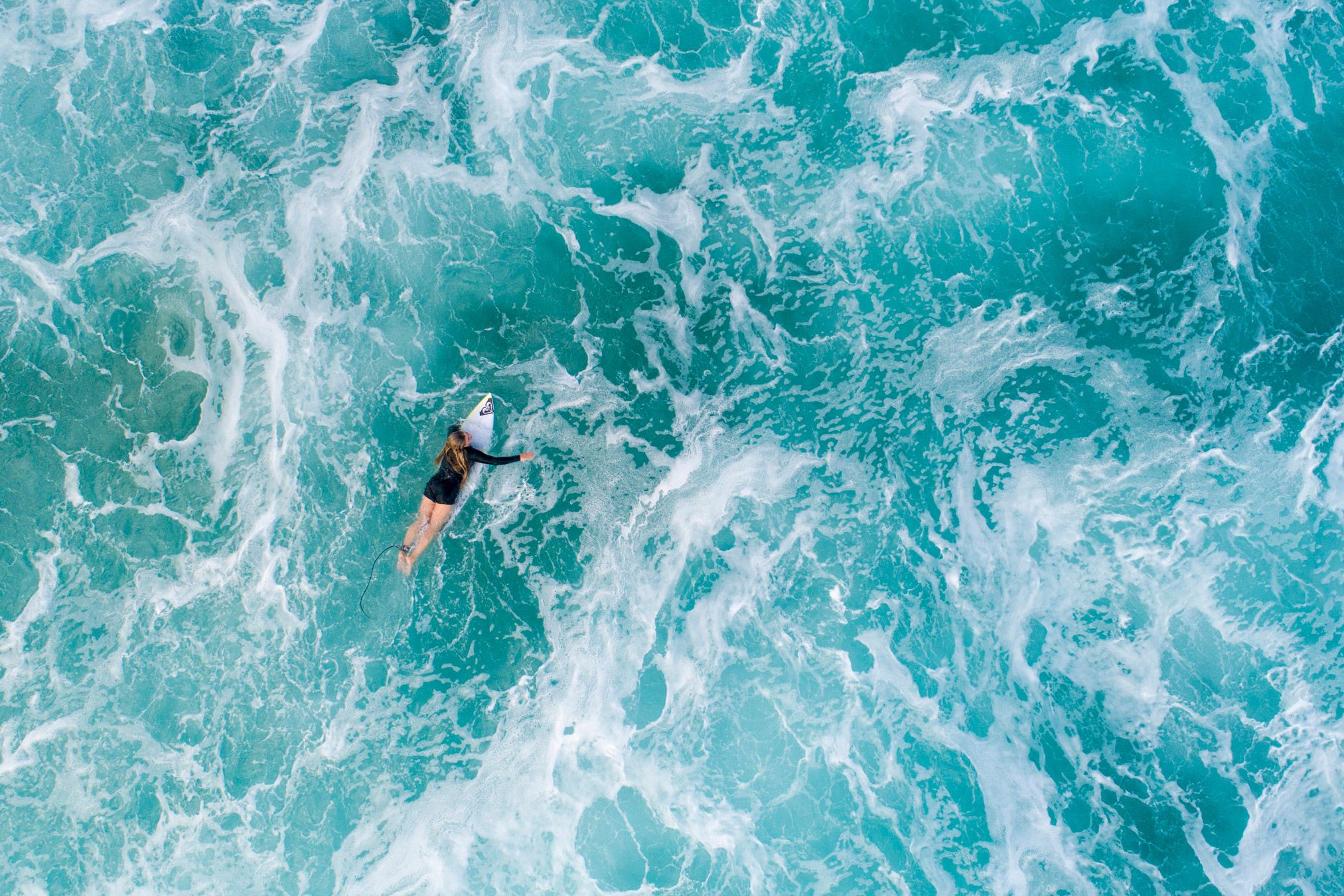
Caroline Marks paddles out at Pupukea, on Oahu’s North Shore.
Moore, who was born in Hawaii, was a surfing prodigy and is the youngest-ever world champion (a title she secured in 2011 at age 18). Coming into Honolua Bay, she is the holder of three world-championship titles. “There’s Carissa in real life—fun, friendly, nice, amazing human,” says Peterson of the soft-spoken 27-year-old Moore. “And then there’s Carissa in a heat, which is just scary.”
Marks, a full decade younger than Moore, is the “grom” (as young newbies are known in the surfing world) who has taken the 2019 CT by storm. She won the season opener in Australia at just 17—while simultaneously plugging away at a homeschool high school diploma. She got into surfing around age 8, after deciding she wanted to be like her brothers, one of whom (Luke) was ranked among the sport’s top U.S. amateurs. “I realized that in order for them to think I was cool, I kind of had to start doing what they’re doing,” she says. “I just fell in love with it.”
Get exclusive access to fashion and beauty trends, hot-off-the-press celebrity news, and more.
Lakey Peterson surfing Honolua Bay on the island of Maui, Hawaii.
Sandwiched between Moore and Marks, in not only the standings but also age (25) and years on tour (eight), is Peterson. When she was a kid, her parents took the family on an around-the-world trip; during a stop in Australia, the California native impressed locals on her boogie board. She entered competitive surfing at age 11 and won the amateur national championship three years later (in 2009). During that event, she also became the first woman to land an aerial maneuver (in which the surfer leaves the water like a skateboarder does on a half-pipe) in an amateur competition. “At that time, I didn’t realize that would be such a groundbreaking thing,” remembers Peterson. “But now I certainly think I see the magnitude of it.” She has since won five tour events. In 2018, she had a breakthrough season and narrowly lost a world-title race that came down to Honolua Bay. Leaving Maui on top this year would mean triumph and redemption.
By 6:30 a.m., all three are taking turns catching waves. Up on the cliff, World Surf League (WSL) officials analyze the swell. Surfing, unlike many sports, doesn’t follow a rigid schedule. Instead, the two-to-three-day competition occurs during a 10-to-12-day window. This allows organizers to pick the best weather conditions and waves—judging by amplitude, energy, and direction, among other characteristics. Jessi Miley-Dyer, the WSL’s VP of tour and competitions, spends the morning consulting with meteorologists, local surf experts, and the judges. “It is very, very finicky out here,” she says. “That’s kind of why Honolua is so special, though. Because when you do get it good, you know that it’s been a real treat.” Day one, however, isn’t, and Miley-Dyer makes the decision not to run, ending her update by telling viewers to “pray for waves.”
Thanksgiving comes and goes without any competition. The waves wash by like salty speed bumps. But rumor has it that rideable swell is on its way.
Surfers have been waiting on waves for centuries, since the sport started in the South Pacific and ancient Hawaii. Surfing was originally unisex: “The women competed with, or against, the men. It doesn’t appear that anyone differentiated,” says Matt Warshaw, author of The Encyclopedia of Surfing and a former pro surfer. An exhibit about the topic at Bernice Pauahi Bishop Museum in Honolulu includes Princess Kaiulani’s board from the late 1800s. The sport suffered around then, though, after contact with the West decimated islanders and missionaries discouraged the sport, finding it indecent. It was in that same era that Hawaiian princes studying at a California boarding school introduced surfing to the United States. In the 1910s, it was popularized worldwide by Duke Kahanamoku. As the sport grew, bigger, heavier boards helped propel a shift in surfer demographics. “It became a male-dominated thing,” says Warshaw. “That was sort of the sad truth of the sport for decades.”
As the exhibit swoops forward in history, the boards get lighter. The last in the exhibit is one of Moore’s current boards, weighing only about seven pounds and covered with sponsor stickers. It’s among just six boards from female surfers out of 20 featured. “There’s always been some really talented, fierce, really engaging women surfers,” says Warshaw. “But the raw numbers were tiny.” They include Margo Oberg, whose board is also on display. A five-time world champion from the 1960s through the ’80s, Oberg is generally recognized as the first woman to turn pro and earn a paycheck from the sport. (Her purse was less than a quarter of the men’s.)
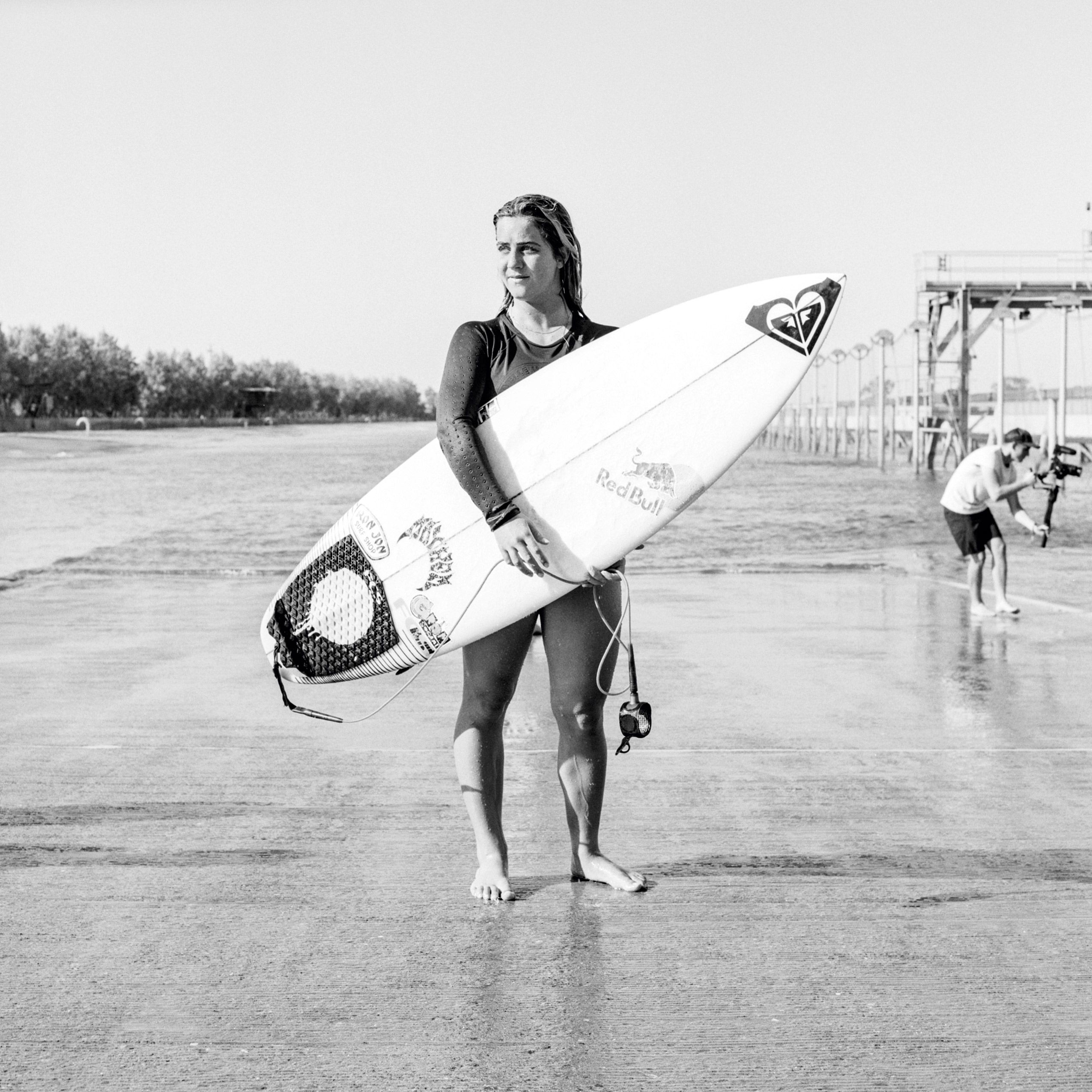
Caroline Marks at Surf Ranch in 2019.
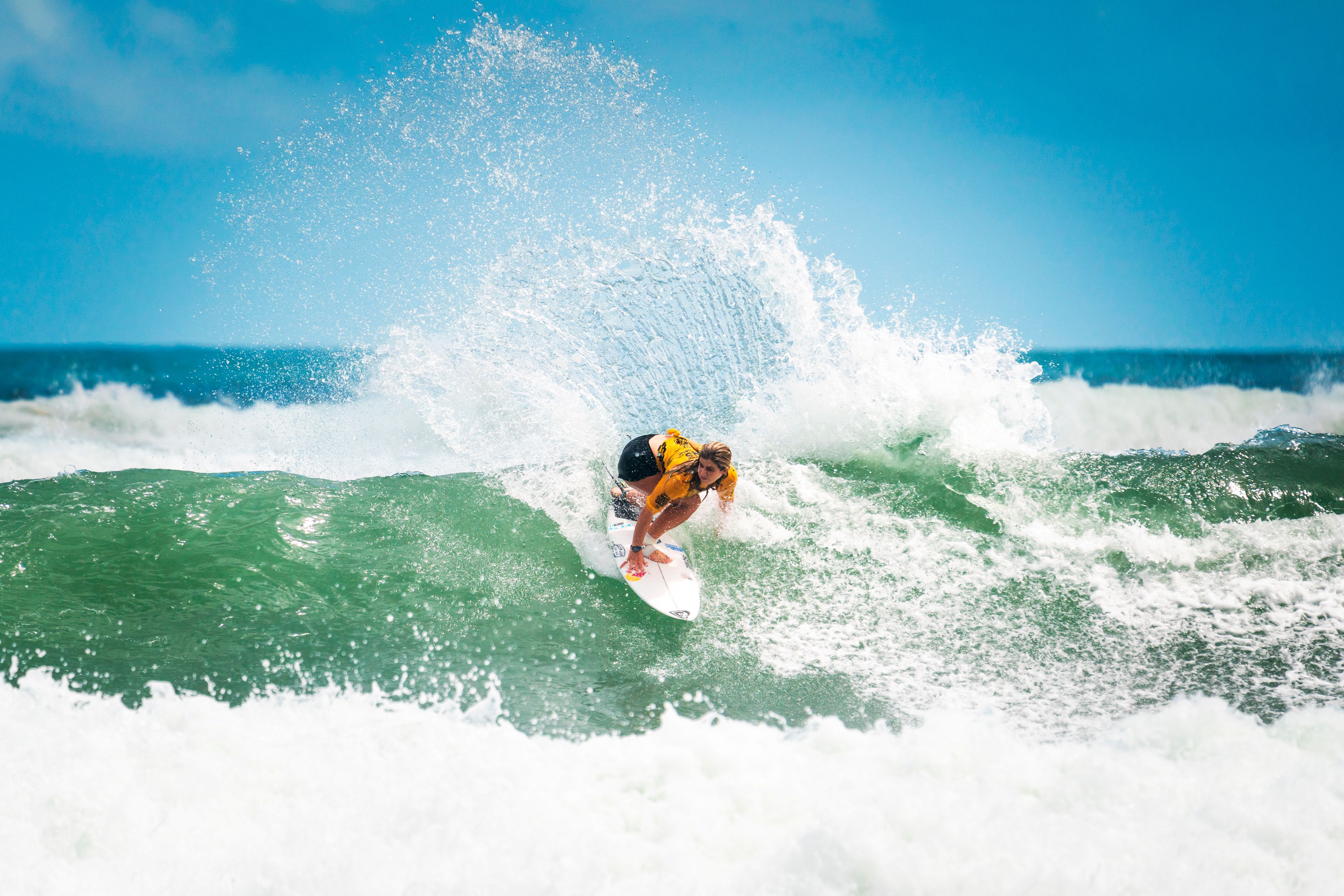
Caroline Marks at the 2019 ISA World Surfing Games in Miyazaki, Japan.
“The one who really broke it open in a really big way,” Warshaw says, “was Lisa Andersen.” A Floridian by birth who moved to California as a teen, she won four consecutive world titles in the ’90s. Warshaw credits her with greatly swelling the female ranks. “From Lisa, you can draw a pretty straight line to Carissa.”
Female surfers have closed the gap on their male counterparts more quickly than women in many other sports have. “They’re pushing themselves in bigger waves. The maneuvers are getting higher above the lip and more progressive,” says Moore. “Their whole performance together has really stepped up.” Moore and Peterson are now seeing more girls than boys surfing at local beaches: “It’s awesome,” Peterson says. Just two years ago, the winner of a CT men’s event would take home $100,000. A women’s event? $65,000. Starting in January 2019, after a multiyear battle for equal pay, the WSL became the first (and only) U.S.-based global sports league to pay men and women the same amount (though sponsorship deals remain disproportionate). “There’s just a complete platform for it to be a legit career path, which is amazing,” says Peterson.
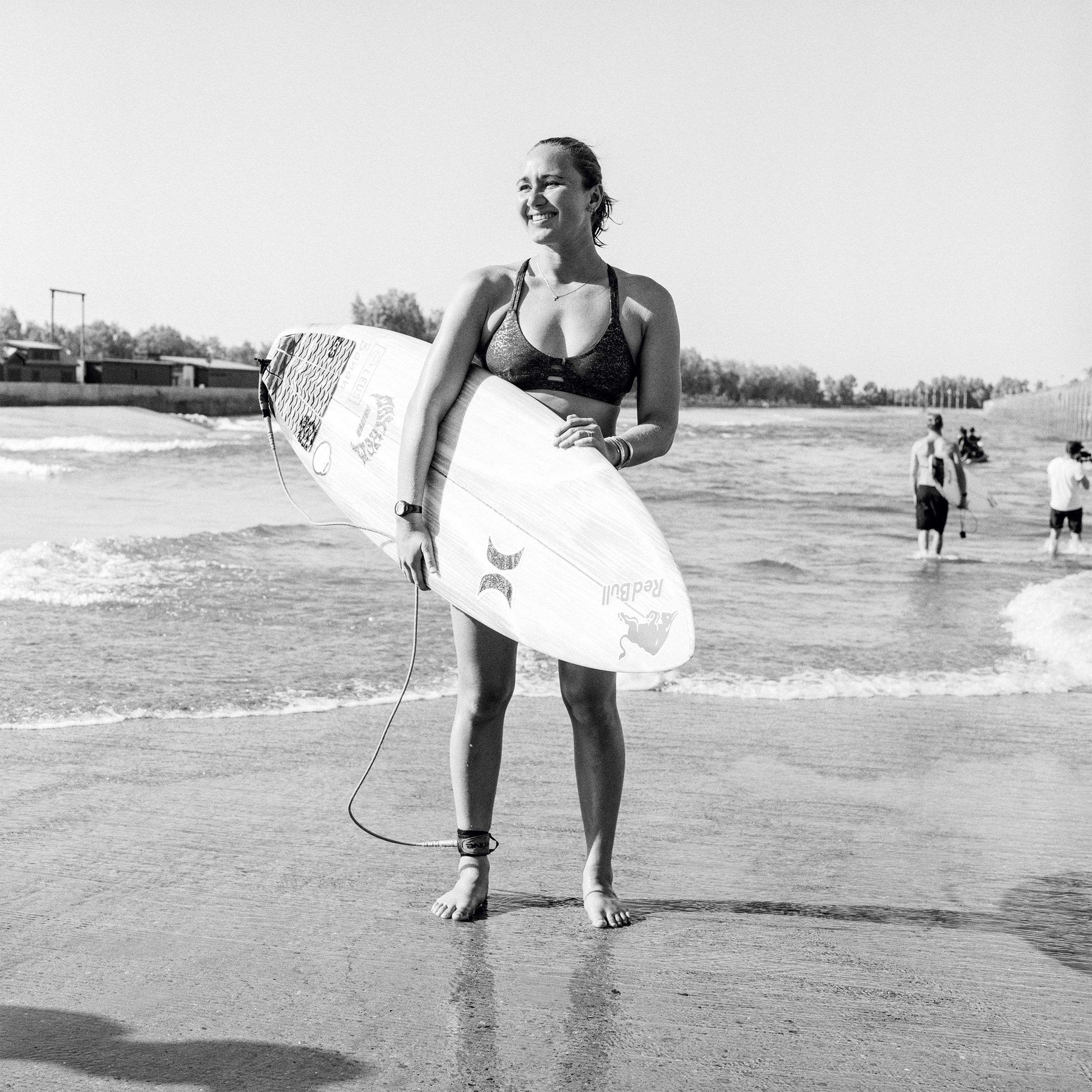
Carissa Moore at WSL Surf Ranch in Lemoore, California, where practice happens on an artificial perfect wave.
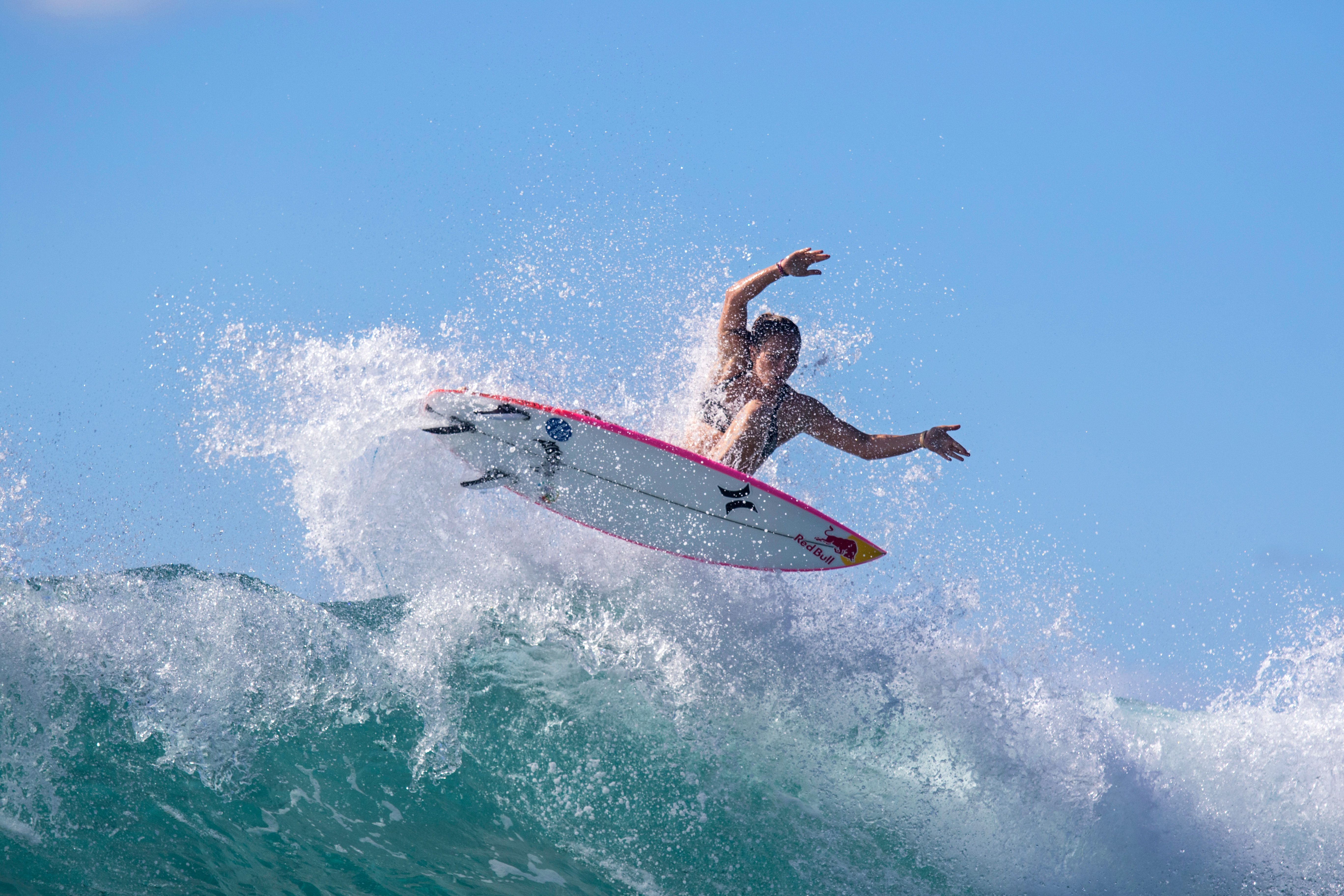
Carissa Moore on a wave at Diamond Head in Oahu in 2017, where she surfed as a kid.
Similar to our nation’s soccer teams—where a struggle for equality has been highly publicized—the female American surfing team is more likely to take home top honors in a global competition than the men on Team USA, who individually rank fifth and seventh in world standings. For all genders, surfing’s status as an Olympic sport is sure to push it up yet another notch in terms of recognition and attention: Win a medal and you’ll be whisked off to late-night talk shows and featured on cereal boxes. That fate seems less likely for the American men than whichever two deeply talented women make the cut.
Carissa Moore fighting for her fourth World Title, at the last event of the 2019 World Surf League Championship Tour.
Back in Maui, Sunday—the seventh day of the window—arrives with steady rain and a new sound: the thunderous crashing of water. The waves of paradise are here. “We’re gonna be on,” says Miley-Dyer. Among the spectators is Greg Cruse, CEO of USA Surfing, to see who he will be sending to Tokyo.
Marks is in the first heat of the day—one of six initial matchups to seed the women for later rounds. Judges score every surf on a variety of criteria, including degree of difficulty, variety of maneuvers, and combination of maneuvers, as well as power, speed, and flow. Each woman’s best two waves combine for a total score. The top two in the heat automatically move on, while the loser is sent to sudden-death elimination. During the first heat, Marks finds herself third. She needs only a 2.50 (out of 10) to retake first, so the numbers are in her favor. The clock, however, is not: With seconds left, she pops up on a wave and lays down turns that look destined to put her back on top. But the judges rule that she got up too late and her ride doesn’t count. She’s sent to the elimination bracket. With Moore and Peterson sailing through their seeding heats, Marks has just one more surf to revive her Olympic chances.
Marks is one of three surfers in the first elimination heat. If she places first or second, she moves on to the next round. If she comes in last, though, she will be sent home—no world title, no Olympics. She’s first to catch a wave. The others, though, are quick to match. Halfway through, the surfers are effectively equal. Then, the youngster takes off. “I believe we will see the highest score of the heat from young Caroline Marks,” calls the announcer. And, with that, she joins Moore and Peterson in the round of 16.
The next rounds are head-to-head. If you lose, you’re done. First up: Peterson, pitted against Australian Tyler Wright, a former world champion who wastes no time jumping into the lead. Peterson, though, recovers on a sharp left turn that sees her drop off the face of the wave, surviving a potential washout. But Wright parries, putting the American back in a hole. With a few minutes left, Peterson needs a 5.07 to advance, an achievable feat given the right wave.
“Take it … don’t wait,” mutters Peterson’s mom, Sue, watching from the cliffs. “This is your last chance.”

Lakey Peterson before competition began in Maui in 2019.
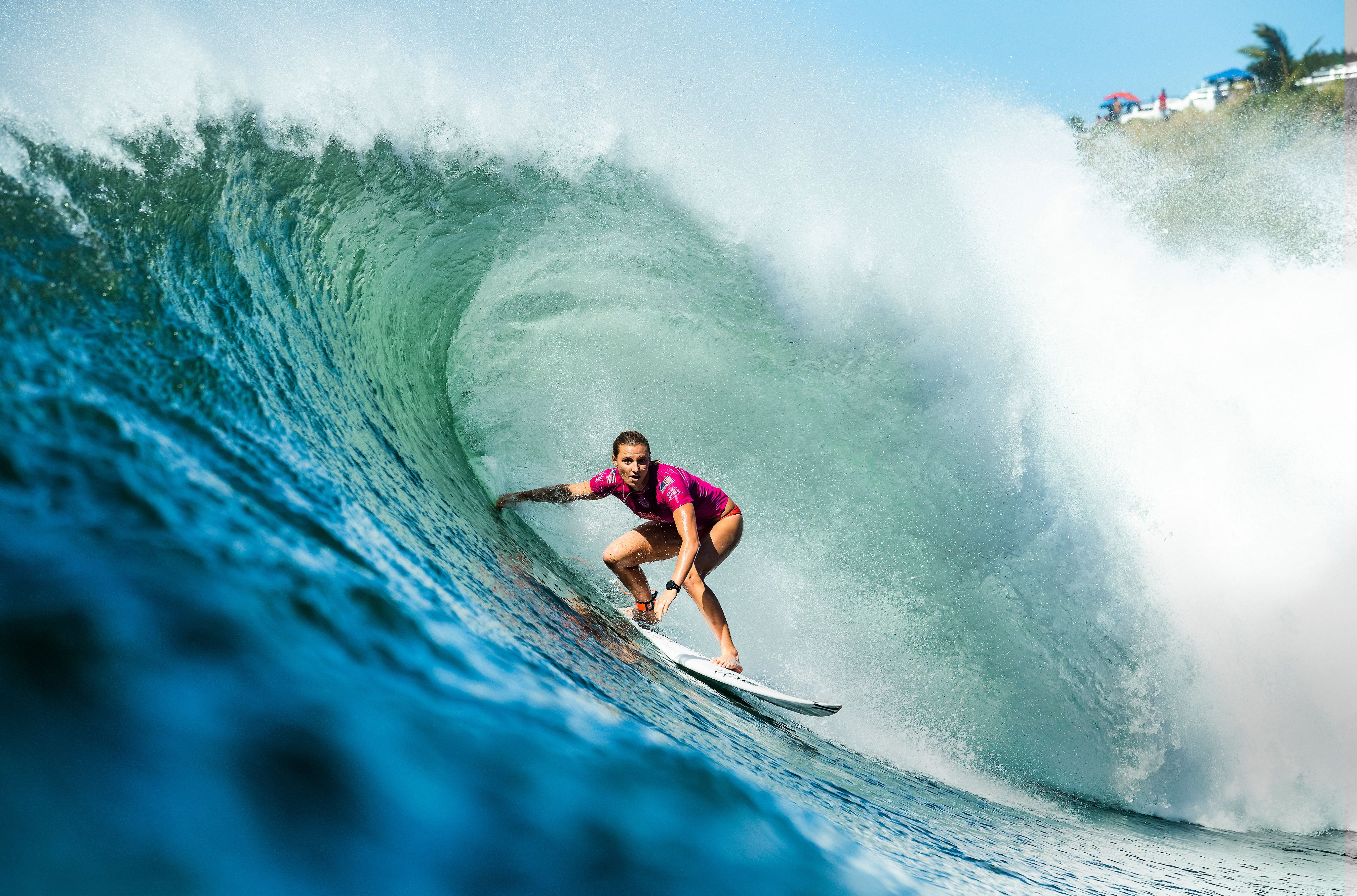
Lakey Peterson competes at the 2018 Beachwaver Maui Pro in Honolua Bay. A year later in that same spot, she would fight for a place on surfing’s first Olympic team.
As Peterson’s heat winds down, she goes to take a wave, but time is up. She walks stoically back to her car. With the loss, Peterson’s shot at a world title is dashed, and Moore’s Olympic ticket—mathematically she can now finish no lower than second in the world—is quietly secured.
Most eyes, though, remain on Marks. “If I make the next heat, I’m in the Olympics,” Marks tells a journalist. As she slips into the water, her family huddles together. “I get nervous,” says her dad, Darren, “but I try to keep it in check.” The announcer leans into the moment. “Most crucial heat in Caroline Marks’s young career,” blare the speakers. “I’m sure everybody up top knows what’s at stake.”
Slicing, carving, and dropping down the faces of waves, Marks is racking up points. But her heatmate, Coco Ho from Hawaii (who ultimately finishes the year tied for 13th place), catches a barrel and nudges back into contention. “Talk about stress, huh?” mumbles Darren. But as seconds tick away and Ho’s good wave isn’t followed by another, cautious excitement sweeps the Marks clan.
“I just want to play the American anthem,” says her mom as Ho’s time is up, meaning Marks has clinched the second Olympic spot. Cruse says with a smile, “I’ve got my team.”
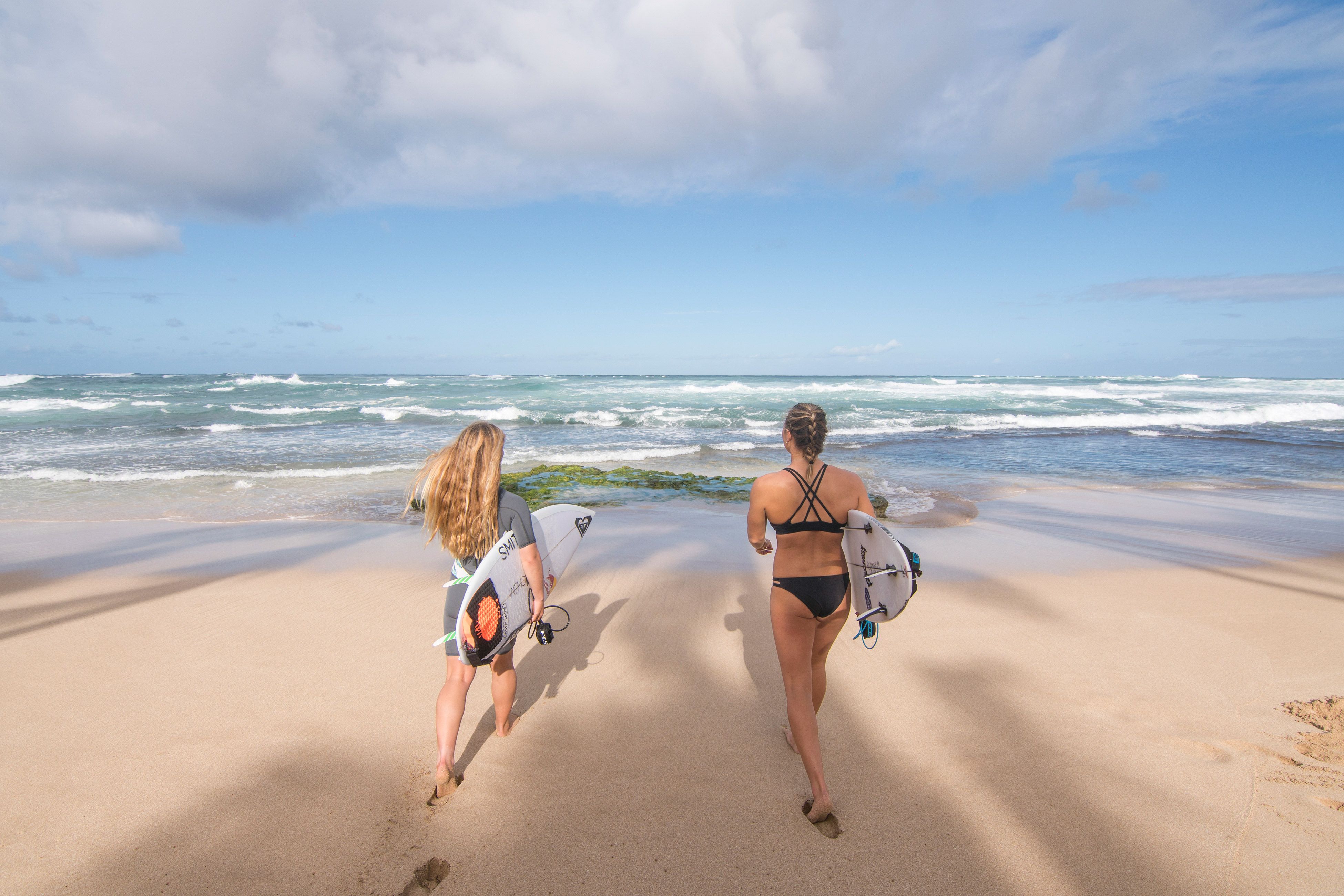
Marks and Moore walk toward the waves at Oahu’s Papailoa Beach.
The rest of the afternoon is a whirlwind, with the WSL presenting Marks, Moore, and the newly qualified Olympians from other countries with commemorative flags. “I haven’t really let myself even dream about it,” says Moore, tears flowing. “I’m so honored.” Marks collects her flag next. “It’s, like, emotional,” she says, as day one at Maui comes to a close. “Something that no one can take away from you.”
The competition, however, isn’t over. Day two is the fight for the world title. Moore sets the bar early and high, catching a barrel along the way. The crowd hollers as the wave curls over her.
It’s Marks’s turn to try to advance; a win would make her the youngest-ever champion. She draws seven-time world champion Stephanie Gilmore and immediately takes the lead. Moore waits in the athlete’s tent out of sight of the ocean, with the crowd noise providing a play-by-play.
Caroline Marks entered the 2019 Honolua Bay event ranked third in the world, behind Lakey Peterson and Carissa Moore.
Halfway through, Gilmore dominates a wave and Marks just can’t catch up. The horn blows, ending the heat, and the scores come in. Marks’s loss is official. Moore jumps up, screaming triumphantly. Sweeping in for an interview, a TV broadcaster tells the audience at home, “We’ve got the world champion: Carissa Moore!”
Moore was already planning to take the 2020 season off, other than the Olympics. But then surfing’s already winding road to the Games is thrown another curve. As the coronavirus crisis creeps across the world, sports leagues—including the WSL—grind to a halt. Then, on March 24, after weeks of speculation, the Olympics are officially postponed to summer 2021.
For Marks, social distancing in the wake of COVID-19 means more time training. “It’s the only thing keeping me sane,” she jokes. She says she continues to prepare “as if it were running tomorrow” and that a delay won’t dampen her spirits. “I was really looking forward to doing it this year, but as long as I’m there, the Olympics are the Olympics.” Moore addresses the postponement on Instagram: “I know this is the best decision for everyone. Same goals. Different date. Just means more time to train and rep the red, white, and blue spray!”
The postponement does provide some respite from the Olympic media circus, which starts for Moore and Marks right after Maui. The duo are rushed off to New York City for a photo shoot with Sports Illustrated, meetings at The Wall Street Journal and Time, and an appearance on the Today show. In a segment that airs on December 9, 2019, cohosts Savannah Guthrie and Hoda Kotb celebrate the unique accomplishment. Onscreen, the chyron reads, “Meet the first two women to make U.S. Olympic surfing team.”
Partway through the interview, Kotb asks the Americans who their biggest competition will be. An easy answer would be Team Australia. But with Team USA holding the top two spots in the world, Marks instead points her thumb toward Moore and says, only half joking, “Her.”
This story was produced in partnership with Newsy.
Loops shot by Luke Piotrowski/Newsy
This story appears in the Summer 2020 issue of Marie Claire.
Lead video: Surfers Carissa Moore, Caroline Marks, and Lakey Peterson prepare to compete at Honolua Bay, Hawaii, in November 2019.
MORE FROM OUR SUMMER ISSUE

